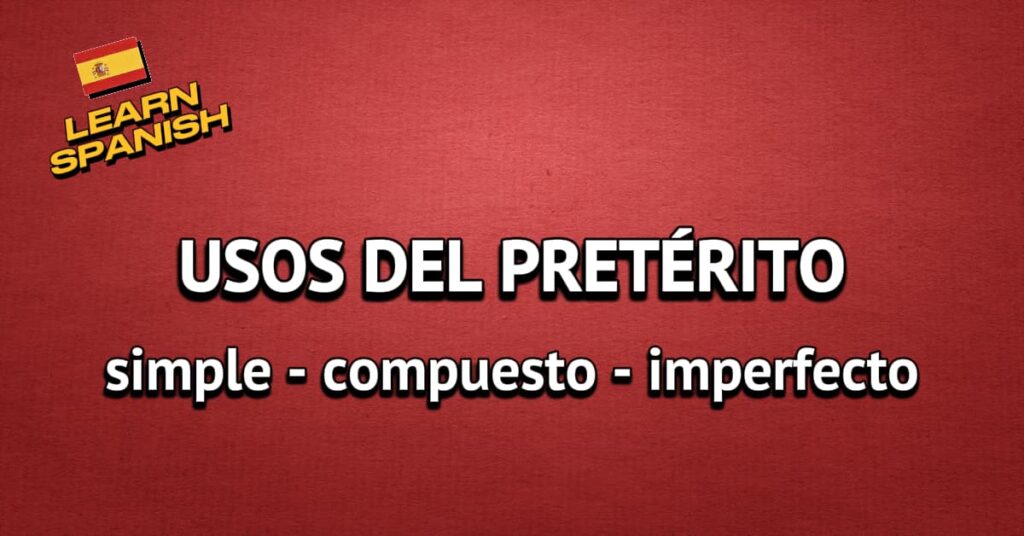Do you know the difference between Spanish preterite tenses?
One of the most common challenges for Spanish learners is mastering the use of Spanish preterite tenses. In fact, Spanish has three main past tenses: the pretérito simple o indefinido, the pretérito compuesto o perfecto, and the pretérito imperfecto. In the following video, I’ll explain the differences between these tenses and how to use them correctly.
Video – Difference between “pretérito simple”, “compuesto” and “imperfecto”
In this video, I use the verb ‘levantarse’ (to get up) as it represents a daily action that allows us to easily understand the difference between the three types of Spanish preterite tenses. I have also used the time markers ‘ayer’ (yesterday), ‘hoy’ (today), and ‘antes’ (before) to clearly differentiate the time of the action. Remember that all actions are in the past, but the time marker determines the verb tense we should use.
✏️ You might be interested in this exercise:
12 frases para practicar el pretérito
Other examples with verbs expressing everyday actions
COMER (to eat)
- Ayer comí pollo con patatas. [pretérito simple]
- Hoy he comido arroz. [pretérito simple]
- Antes comía carne. Ahora soy vegetariano. [pretérito imperfecto]
IR (to go)
- Ayer fui a la universidad. [pretérito simple]
- Hoy he ido a la universidad. [pretérito simple]
- Antes iba al colegio. Ahora voy a la universidad. [pretérito imperfecto]
ESTAR (to stay)
- Ayer estuve en casa todo el día. [pretérito simple]
- Hoy he estado en casa todo el día. [pretérito simple]
- Antes estaba en casa todo del día. Ahora salgo temprano, voy a caminar, voy al gimnasio y como fuera. [pretérito imperfecto]
In these examples, you can see that the imperfect is always compared to the present, which is why we use expressions like ‘antes’ (before) and ‘ahora’ (now). This comparison doesn’t have to be explicit, but the listener understands that the present is different from the past. So, if you tell me ‘Antes tomaba leche’ (I used to drink milk), I immediately understand that you don’t drink milk now.
Look at this example:
- Antes tomaba leche.
- ¿Y ahora tomas té?
- Sí, me encanta el té.
In this example, it’s clear that there’s no need to include the phrase ‘ahora no tomo leche’ (I don’t drink milk now) because the expression ‘antes’ (before) and the imperfect tense make it perfectly clear that this was a repeated action in the past, but not in the present.
The time markers express the difference between “pretérito simple” and “pretérito compuesto”
There are not only ayer, hoy, antes and ahora. There are many temporal markers that express past or present tense. Here is a list of temporal markers that you can use to express the difference between Spanish preterite tenses.
Pretérito simple time markers
- ayer
- la semana pasada
- el mes pasado
- el año pasado
- el verano pasado
- en 2019 [cualquier año terminado]
- el 5 de octubre de 2013 [cualquier fecha del pasado]
Pretérito compuesto time markers
- hoy
- esta semana
- este mes
- este año
- este verano
- últimamente
- todavía no
- ya
Imperfecto time markers
- antes
- cuando era niño/niña
- cuando era pequeña/pequeño
- cuando vivía en…
- cuando estudiaba en…
- cuando estaba en…
- otras expresiones con «cuando» + verbo en imperfecto

¿Te gusta practiquemos.com?
Dame 5 estrellas. Me ayudas mucho 🙏
Give me a 5-star rating
¡Muchas gracias!
★★★★★

